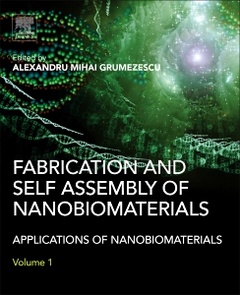Fabrication and Self-Assembly of Nanobiomaterials Applications of Nanobiomaterials
Auteur : Grumezescu Alexandru

Fabrication and Self-Assembly of Nanobiomaterials presents the most recent findings regarding the fabrication and self-assembly of nanomaterials for different biomedical applications. Respected authors from around the world offer a comprehensive look at how nanobiomaterials are made, enabling knowledge from current research to be used in an applied setting.
Recent applications of nanotechnology in the biomedical field have developed in response to an increased demand for innovative approaches to diagnosis, exploratory procedures and therapy. The book provides the reader with a strong grounding in emerging biomedical nanofabrication technologies, covering numerous fabrication routes for specific applications are described in detail and discussing synthesis, characterization and current or potential future use.
This book will be of interest to professors, postdoctoral researchers and students engaged in the fields of materials science, biotechnology and applied chemistry. It will also be highly valuable to those working in industry, including pharmaceutics and biotechnology companies, medical researchers, biomedical engineers and advanced clinicians.
Chapter 1: Synthesis, characterization and applications of nanoparticles
Chapter 2: Self-assembled nanostructure: preparation and applications
Chapter 3: Self-assembly of nanobiomaterials
Chapter 4: Self-nanoemulsifying systems for oral bioavailability enhancement: recent paradigms
Chapter 5: Sensing of reactive oxygen species by self-aggregating gold nanoparticle assemblies
Chapter 6: Plant-mediated green synthesis of metallic nanoparticles: challenges and opportunities
Chapter 7: Exosomes: smart nanospheres for drug delivery naturally produced by stem cells
Chapter 8: Controllable synthesis of lanthanide upconversion nanomaterials through impurity doping
Chapter 9: Nanocellulose—fabrication, structure, properties, and application in the area of care and cure
Chapter 10: Magnetosensitive nanocomposites with hierarchical nanoarchitecture as biomedical nanorobots: synthesis, properties, and application
Chapter 11: Designing and testing single tablet for tuberculosis treatment through electrospinning
Chapter 12: Synthesis, characteristics, and biocidal activity of silver nanoparticles
Chapter 13: Nanobiomaterials: applications in biomedicine and biotechnology
Chapter 14: Control, design, and understanding of molecular self-assembly
Chapter 15: Self-assembly of transition metal nanoparticles using marine sources
Academic: Materials science, biotechnology and applied chemistry professors, PhD, MsC, postdocs, upper level undergraduate students.
Industry: Pharmaceutics and biotechnology companies, medical researchers, biomedical engineers, advanced clinicians.
- An up-to-date and highly structured reference source for practitioners, researchers and students working in biomedical, biotechnological and engineering fields
- A valuable guide to recent scientific progress, covering major and emerging applications of nanomaterials in the biomedical field
- Proposes novel opportunities and ideas for developing or improving technologies in fabrication and self-assembly
Date de parution : 01-2016
Ouvrage de 528 p.
19x23.3 cm
Thèmes de Fabrication and Self-Assembly of Nanobiomaterials :
Mots-clés :
Amorphous nanoparticles; Antituberculosis; Applications; Bacterial nanocellulose; Biocidal activity; Biocompatible; Biomedical applications; Biomedicine; Biosensors; Biosynthesis; Biotechnology; Broth dilution method; Cellulose nanoyarn; Chemical reduction; Controlled drug delivery system; Core-shell; Crystalline nanoparticles; DNA; Doping; Drug delivery; Drug delivery vehicle; Electrospinning; Exosome; Fabrication; Fabrications routes; Gold nanoparticles; Green synthesis; HIV; Hepatic first-pass metabolism; Impurity; In situ sensing; In vitro recrystallization; Lipid-based systems; Liposome; Luminescent materials; Magnetosensitive nanocomposites; Marine microbial sources; Medicobiological nanorobots; Metallic nanoparticles (MNPs); Minimum bacteriocidal concentration; Minimum inhibitory concentration; Molecular biotemplating; Multilevel hierarchical nanoarchitecture; NaLnF4; Nanobiomaterials; Nanocarriers; Nanocellulose; Nanofibrillated cellulose; Nanomaterials; Nanoparticle; Nanoparticles; Nanosilver; Nanostructures; Nanotechnology; Nano-bio interface; Oxidative stress; P-gp efflux; Peptides; Photoacoustic spectroscopy; Physicochemical properties; Plant extracts; Polymer composites; Properties; Protein corona; Protein payload; Proteins; Rare earth ions; Reactive oxygen species; S-layer proteins; SNEDDS; SRM; Scaffolds; Self-assembled monolayer (SAM); Self-assembly; Silver nanoparticles; Sporosarcina ureae ATCC 13881; Stem cell; Stem cell released molecules; Structure; Synthetic biology; Systems therapeutic; Targeted drug delivery; Tissue engineering; Transition metal; Tuberculosis; Upconversion



